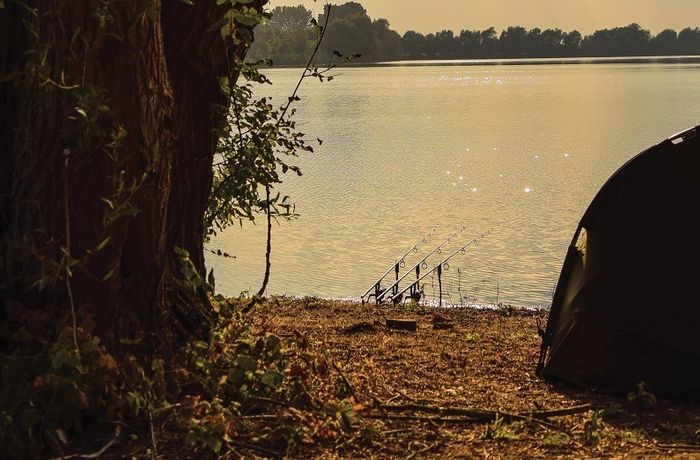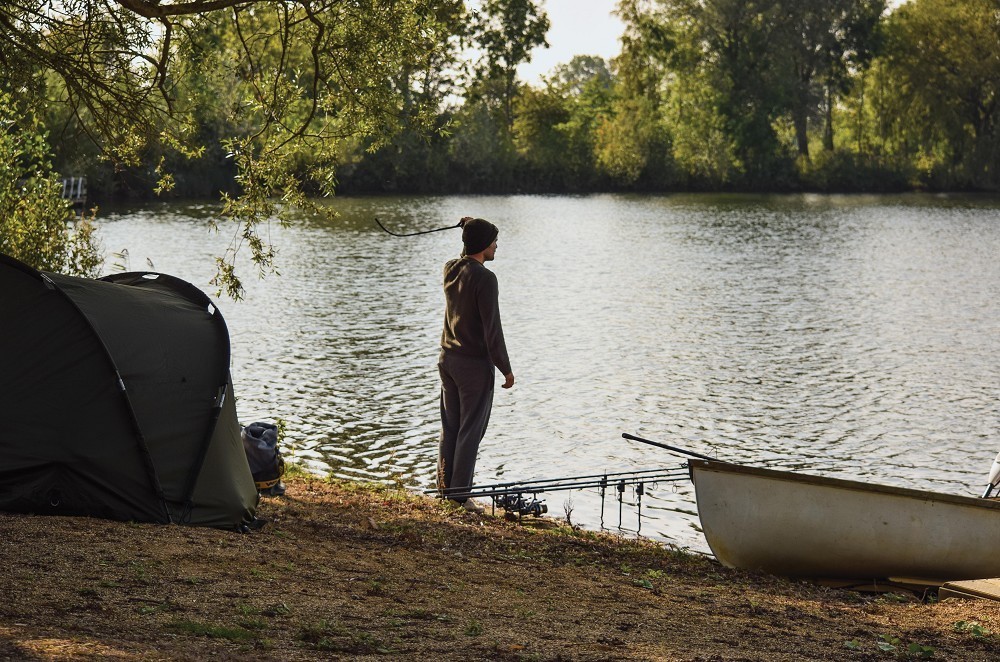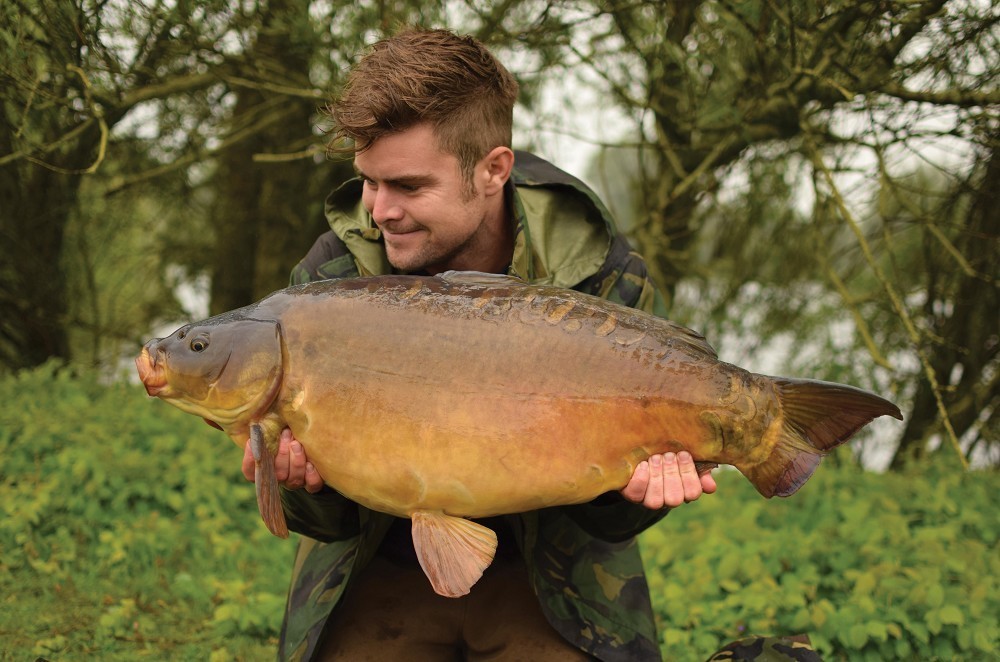How James Armstrong conquered 'the sea'
No bullsh*t, just good solid angling

120-acres of water, boats, campers, a low stock of carp and hordes of tench: it doesn’t sound like fun, but boy did Jimmy Armstrong love it…
It was massive, it was like a small ocean. Over 120-acres of turbulent, windswept gravel pit. With a small number of carp residing in the sea-like water, compared to its size, it was never going to be easy to tempt one of its inhabitants. In fact, my target was to simply catch a carp from there to begin with. It was notoriously hard and demanded respect. Consequently, I am writing this piece due to the incredible adventure I had on there, whilst I could. Unfortunately, it is a venue that I am unable to fish these days, due to problems on the site, which is a gutter as I was just getting to grips with the place, but I wanted to talk about my time on there, because eventually I was able to catch some amazing carp. Not the biggest fish I have ever caught, but certainly ones that I cherish in my album. They were raw, angry specimens, carp with attitude that knew exactly what it took to catch them. One of the most difficult parts was the huge number of tincas. There were thousands of them. I am not just talking 3-4lb fellas either… I’m talking big ‘uns – 8, 9, 10-pounders. Specimens that easily mop up a bed of 15-millers! This was one of a few tasks that I had to overcome…
Case Study 1: Getting past the tincas
It was on my very first session that I was to experience these green goblins completely smash my area to bits. It was early April and I had been pre-baiting regularly over a number of weeks. The lake is weedy and gin clear. Through experience I have found that the beginning of a spot looks like a small patch of silt amongst weed with the very odd fleck of shingle on it, possibly the odd strand of weed too. I explored the lake throughout those first few weeks and opted to bait up four areas of the lake, mainly the corners.
Drifting around in my wooden boat, head over the side glued to the Aquascope, I was able to gain a good idea of the make-up of the lakebed. I soon settled on four areas, all amongst weed. My feeling was that if I could find the beginnings of a spot, I could feed, feed and feed, harvesting the spot into an area that the carp would associate with food. Consequently, I started to prepare and boil up barrels of particles at home in readiness to start feeding, which I did.
Two or three times a week would see me heading up to Cambridgeshire to bait the areas. Using little Fox H Blocks I had the areas permanently marked. No one else was fishing so it was just me against the fish. I battled it in all weathers. One day would see me in polaroids enjoying the spring sunshine scattering particles all over my spots while another day would be torrential April showers with the motor constantly on 1-thrust as I bobbed over the waves to try and keep in position.
The particle mix consisted of wheat, groats, parti-blend, chopped nuts and boilies… anything I could get in bulk for
a reasonable price.
The spots were getting cleaner and cleaner, no doubt, and what I was later to find out, was probably shoals of tench. I never mind smaller species feeding on my spots as it helps to clear out the weed and keep them polished. It also keeps it rocking. Carp are inquisitive souls and will therefore attend a party if they see others banqueting on a free meal.
I remember that first session like it was yesterday. I got all the rigs ready, corkball pop-ups on Hinges to helicopter rigs. Pacific Tuna hookbaits soaked in Tuna L030 and sea salt. I was fishing opposite a huge island in the boating area of the lake. My H Blocks were bobbing in the wind at a distance of around 80yd on a few clearings that I’d created with consistent feeding. Although I hadn’t seen any fish showing, it looked as good a place as any to start my season on the big lake. Something had been feeding!
I hopped into the wooden boat and along with the pooch, a rod, and a bucket of bait I flicked on the outboard and bobbed my way out to the first H Block. I opened the bail arm and flicked it out to the mark, feeling the lead down with a notorious donk indicating firm terrain. I followed this with a few scoops of bait (a mixture of all sorts), left the bail arm open and popped the rod tip under the water to keep all the braid sunk. With one arm holding the rod, and the other steering the boat, I slowly made my way back to base camp. I did this with the other two rods, but on different markers, and soon settled back to watch the water.
At midnight, those short sharp bleeps began. You know the ones that crash the bobbin to the blank, and then fall back and then shoot back up again and just hold. Yes, a tench bite! This just kept on happening and by morning I’d tallied up six tench, yes, six of the blighters. Now I love all species of fish, and tench are beautiful creatures, especially the fact that they were over 9lb, but not on carp gear, and especially not when I was targeting such prestigious fish.
The first few weeks were tricky, I cut down the amount of particles I was using, introducing more boilies and nuts, but I was still catching on 15mm hookbaits. The way I started to get around it however, was pre-baiting with particles, keeping everything coming to the party, fishing only 18mm boilies on the session itself, including 18mm corkball pop-ups with size 4 hooks.
It was on a gloomy April afternoon that I finally hooked into my first carp on the water. I was standing there talking to one of the lads who lived in a house on-site and the right-hand rod ripped into life. In fact, it went at such a rate of knots, it pulled the rod off the rest. I grabbed for the rod and it steamed off immediately before hitting a weedbed. As it was solid, I reached for the boat and pulled myself out to the fish.
Eventually I got above her before easing her free, plus a huge ball of Canadian. She towed me around in open water for around 15 minutes before I could finally scoop up my prize: a mirror with huge plates on its flanks lay before me.
She was a real character, with a few old battle scars and these peculiar bulging eyes – a special creature. Needless to say I was on Cloud Nine, unfortunately my camera was in repair at the time and I only had my iPhone so the snaps are a little amateur but at least I managed some.
Case Study 2: Breaking up the lake into other lakes
120-acres is daunting, seriously, trust me! In a powerful wind, water skiers, buoys, waves crashing into the bank, the prospect of catching can be a tall order and at times you wonder where on earth to start.
To ease my mind and make the whole adventure a little more comfortable, I broke the lake up into four sections, almost treating it like different lakes. I baited four zones in each lake and kept it going in. The fish would move around a lot and so I would choose which section, and spot, to target depending on where I found them. Early mornings and late evenings were very good times for fish spotting although they were always subtle. Never once did I see one properly head and shoulder. They would lightly break the surface with a tail slap or swirl, possibly on hatches. As a consequence, my eyes had to be fixated on the water’s surface to see the signs. By breaking up the lake it made things a lot easier when baiting and fish spotting, also potentially moving onto fish.
The big lake was a water that I identified how important it was to keep awake, sometimes in the early hours of the night. I nearly went to the extent of purchasing some night vision goggles. It was on a still, calm, starry night that I sat there sipping a cup of tea. The moon was beaming, and reflecting off the water’s surface. It was particularly light. I sat on the edge of the boat which was moored up in the margins watching the water, and in the light of the moon I watched ripples appear. A subtle surface swirl shortly followed this, followed by another bosh. They were showing at night around 100yds to my right. There weren’t any obstacles between the showing fish and me and so I walked a rod up the bank and flicked a Choddy out to the showing specimens. It was a stinky Pacific Tuna pop-up soaked in L030. I flicked it out feeling it down onto low lying weed and then proceeded to scatter some baits around the rig, roughly in the area.
A few hours later, the rod ripped into life and I was latched into a hard-fighting specimen, which resulted in a corking mirror over 30lb. He was a funny character with these tiny goldfish like lips, the complete opposite of the gnarly old plated mirror that I caught previously.
Lesson learned: they showed at night. Consequently, I would often get some sleep in the daytimes sitting up for a few hours
in the dark, listening for shows!
 For my main stay angling, I baited areas at around 80yd, just to keep things tidy really – a distance that even in the windiest gusts I could happily fish and bait up at
For my main stay angling, I baited areas at around 80yd, just to keep things tidy really – a distance that even in the windiest gusts I could happily fish and bait up atCase Study 5: Margin spots
Contrary to popular belief, you don’t need to fish miles out into the lake in order to catch from a big water. Fish where the fish are! For my main stay angling, I baited areas at around 80yd, just to keep things tidy really – a distance that even in the windiest gusts I could happily fish and bait up at.
However, on a bright, late-spring session, the sun was beating down onto the water’s surface. It was flat as a millpond, perfectly calm. Off the end of a point, I had a small, intimate bay to my right; it was a weedy bay, top to bottom with Canadian pondweed. I stood there watching the water when I saw the scum on the surface of the water wobble and rock. I stood there like a heron watching his prey, silent. A decent fish then appeared from out of the gloom and ghosted over the weed. A flick of the tail and it surged over the towering Canadian. Three more fish then shortly followed. I tiptoed back to the bivvy and hatched a plan.
Due to the dense weed, I tied up a Choddy with the top bead pulled right up several feet on the leadcore and I attached a Heli Safe to ensure that the lead would detach in the case of a take. A nice, long Chod section of around four-inches was tied out of my trusty Bristle Filament and I then tied on a 15mm Pacific Tuna corkball. A 1oz lead was clipped onto the Heli-Safe.
I crept back to the margin, checked to see if any fish were present, and when the coast was clear I under-armed the rig 10yd or so out so that it sat nicely on top of the weedbed. The little lead plummeted to the bottom of the weed, the corkball shot up to the top bead and it slowly fluttered down on top and the nice long pop-up section hovered above. I then squeezed 30 or so baits in my fingers. By doing this, they would sink a lot slower through the water and settle in the weed rather than burying out of sight. I also crumbled a few up.
Through the polaroids in the gin-clear water I could see my pop-up perfectly in the weed along with the bits and pieces around it. I created a little line of bait from left to right.
The braid was sunk and slackened off allowing it to sink and I placed it onto the single sticks.
I sat back away from the water’s edge on the high bank and enjoyed the warm springtime sun. A few hours passed and then the shrill of a Neville had me leaping to my feet. I grabbed the rod and the fish stripped line from a tight clutch. I put the lifejacket on and climbed straight into the boat. After a tricky battle and a few hairy moments after finding some heavy weedbeds eventually I scooped up an incredible scaly mirror. A fish caught within yards of the bank on 120-acres, simple really! I managed another fish on this tactic: a strange koi-type character.
The Sea was one of my most challenging but enjoyable adventures that unfortunately came to an all-too early close. There was plenty more to go at and I was just beginning to piece together the jigsaw. With a bit of luck I will be back one day for another of its jewels!




